Master the Kettlebell Swing for Full-Body Benefits
Instructions
1. Starting Position
- Feet: Place your feet slightly wider than shoulder-width apart, with your toes pointed slightly outward.
- Grip: Grab the kettlebell handle with both hands, keeping your arms extended straight in front of you. Your palms should face toward your body, and your thumbs should wrap around the handle.
- Posture: Keep your chest proud, back neutral (flat), and shoulders pulled down away from your ears. Maintain a slight bend in your knees.
2. Hinge and Load
- Hinge at the hips: Push your hips back (not down like a squat), which will cause the kettlebell to drop between your legs. Your back should remain flat and not rounded.
- Brace your core: Engage your abs to protect your lower back, and maintain a neutral spine throughout the movement.
- Load the hips: The kettlebell should swing down just past your knees or mid-shin height.
3. The Swing
- Powerful thrust: Drive your hips forward powerfully to propel the kettlebell up. The force should come from your glutes and hamstrings, not your arms. The hips should extend fully, and the torso should rise to an upright position.
- Kettlebell height: The kettlebell should rise to about shoulder height, or slightly higher, depending on the type of swing you're performing (Russian vs. American).
4. The Descent
- Controlled descent: As the kettlebell falls back down, guide it with your hips, keeping a strong hinge motion. Resist the temptation to squat or bend your knees too much.
- Repeat: As soon as the kettlebell reaches the bottom, thrust your hips forward again and repeat the swing for the desired number of reps.
Tips
-
Engage the glutes: The kettlebell swing is a hip-driven movement. Focus on squeezing your glutes at the top of the swing to maximize power and prevent lower back strain.
-
Neutral spine: Always maintain a neutral spine. Avoid rounding your back or looking up too much, as it can strain your neck and lower back.
-
Use your hips, not your arms: The kettlebell swing is driven by the force generated from your hips. Your arms should be relaxed, and they will act as a guide for the kettlebell, but the power should come from your core and legs.
-
Breath control: Exhale sharply through your mouth as you thrust your hips forward and inhale as the kettlebell swings back down.
-
Don’t squat: Unlike squats, the kettlebell swing uses a hip hinge motion, not a squat motion. Keep your knees slightly bent, but focus on hinging your hips back.
-
Kettlebell height: For a standard Russian swing, the kettlebell should swing to shoulder height. In an American swing, the kettlebell can go overhead, but make sure your core is strong enough to stabilize your body in that position.
-
Control the kettlebell: Avoid letting the kettlebell "pull" you down too fast or letting your body be too lax. Control the swing on both the ascent and descent to prevent injury.
-
Start with a light weight: If you’re new to kettlebell swings, begin with a lighter kettlebell to practice the form. Once you feel comfortable with the movement, gradually increase the weight.








